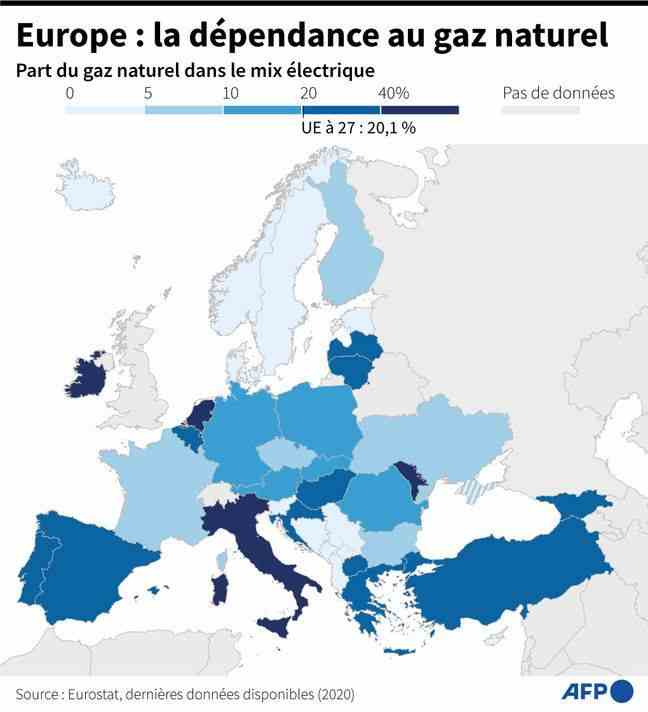Volodymyr Zelensky went to Izium on Wednesday, promising the Ukrainians “victory” and stressing that “almost the entire Kharkiv region”, bordering Russia, was now “liberated”, thanks to a counter-attack. – offensive started at the beginning of September. “Four hundred and fifty graves” were discovered near Izium, a city in eastern Ukraine, presidential adviser Mykhaïlo Podoliak said on Friday. In order to verify these allegations, the Office of the High Commissioner for Human Rights of the United Nations wishes to send a team on the spot “soon”. Here is a point in four infographics on this new week of war in Ukraine, ending this Friday, the 204th day of conflict.
In the East, the dazzling breakthrough of the Ukrainians
Ukrainian President Volodymyr Zelensky visited Wednesday in Izioum, a strategic city reconquered in the Kharkiv region (east). This is his first visit to the territories recaptured from the Russians this month during a dazzling counter-offensive. Faced with a counter-offensive in the south, a surprise breakthrough in the northeast and no less than 5,000 km of territory recovered, Moscow’s troops have no choice but to retreat. A turning point in the war where, so far, the advances of the Russian troops were much more notable than those of the Ukrainians.
In response, the Russian army, whose strikes have caused major power cuts in several Ukrainian regions in recent days, said Wednesday that it was pounding Ukrainian forces in all directions, particularly in the Kharkiv region. Many experts point out, however, that Moscow was taken aback by this counter-offensive. That Russia did not see it coming “is a colossal failure of military intelligence”, believes Michael Kofman, of the American institute CNA. They “completely missed it”. “Russia did not know how to anticipate”, abounds Pierre Grasser, historian of international relations and researcher at the Sirice laboratory in Paris.
The gas war

Kyiv continues to encourage the European Union to “resist energy pressure” from Moscow. Energy is by far the largest component of inflation in the euro zone with a rise of 38.3% over one year according to Eurostat’s first estimate for August. A situation that weighs on the entire economy by raising the production costs of companies. The situation has become so critical that some factories, or even swimming pools in France, have closed to avoid excessive bills. However, some countries are more dependent on natural gas than others, as this map shows.
France, for example, is more protected thanks to an energy mix mainly based on nuclear power. Either way, European countries are moving away from Russian gas. And energy independence is necessary (on a European scale at least) because Moscow is turning towards the East. On Thursday, the Russian Energy Minister announced that the Force de Siberia 2 gas pipeline, under discussion for several years between Moscow and Beijing, “will replace” Nord Stream 2, which was to link Russia to Europe and whose implementation service has been discontinued since the conflict in Ukraine.
Many civilian casualties

Many civilians have been killed since the start of the Russian invasion of Ukraine. According to the UN, at least 13,917 Ukrainians have died since the start of the war, even if this toll only counts the deaths that Westerners have been able to authenticate. In reality, the victims are most likely far more numerous. On this map, we can see the civilian deaths recorded by the NGO Acled on September 9.
This macabre tally could well gain momentum quickly with the Ukrainian counter-offensive. This Friday, the Ukrainian authorities discovered hundreds of graves in a forest on the outskirts of Izium, a town recently recaptured from Russian forces in the Kharkiv region, an area where the police add that they have discovered ten “torture rooms”. According to local authorities, a total of 443 graves were discovered on this site, including a grave containing the bodies of 17 Ukrainian soldiers.
Those who receive the wheat

Since the beginning of the Russian invasion, more than six months ago, kyiv has received large financial envelopes. But wheat is also those cereals that have difficulty getting out of Ukraine, in the middle of the war. Of the approximately 58 million tonnes of grain storage capacity in Ukraine, the Russians took control of 6.24 million and 2.25 million were destroyed. These significant losses call into question Ukraine’s ability to continue its role as breadbasket for many countries, which depend on the country for their supplies of wheat, corn and sunflower in particular.
Moscow is increasingly contesting two agreements concluded in July in Istanbul allowing the export of these foodstuffs from Ukraine despite the Russian offensive, but also, in theory, exports from Moscow which have been affected by Western sanctions. The Kremlin claims in particular that most Ukrainian food products go to European countries, which kyiv denies, and complains of obstacles to the export of Russian cereals and fertilizers. We can see from this infographic that Ukrainian cereals are not exclusively sent to Europe. Still, Russian criticism is raising fears that Ukrainian exports will be further hampered, as the conflict raises concerns for global food security.

